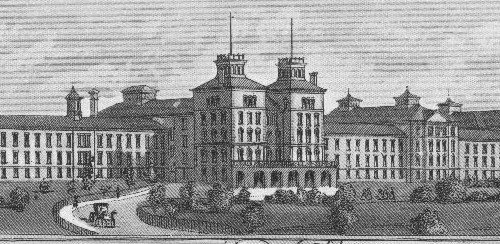Featured
- Get link
- X
- Other Apps
The Lady in the Asylum: Catherine Gilbride at Danville: Part IV
 |
| Danville Asylum as it looked prior to a Spring 1881 fire which destroyed the female wards. |
by Nancy Gilbride Casey
Catch up on the first three installments in The Lady in the Asylum: Part I , Part II, Part III.
Danville Asylum
The Danville Asylum into which Catherine Gilbride walked was unlike anything seen in Northeast Pennsylvania at the time. The formidable building, newly opened in 1868, was on the forefront of the treatment of patients with mental illness, who previously would languish in jails or almshouses, facilities ill-equipped to provide care for such inmates. Danville was a far cry from dungeon-like cells, chains and drear called to mind by images of asylums such as London’s infamous Bedlam.
Moral treatment, first practiced in France and England, consisted of “...removing patients from their homes to an asylum that provided the patient with an intimate family atmosphere.” It was “built on the assumption that those suffering from mental illness could find their way to recovery and an eventual cure if treated kindly and in ways that appealed to the parts of their minds that remained rational.2 Gone were the use of force, coercion, and shackles; these were replaced by humane vigilance by caretakers, and gentler medical treatments, delivered in secluded and quiet settings. It was thought that this milder treatment of patients would allow for the restoration of their mental health. In fact, Kirkbride wrote in 1854, “Of the recent cases of insanity, properly treated, between 80-90 per cent recover. Of those neglected or improperly managed, very few get well.”3
As Kirkbride sought to “...create a humane environment based upon compassion and respect for the insane,” he envisioned a new type of building, featuring three stories and a cellar, with two wings—one wing each for male and female patients. Each wing contained eight wards—six on the second floor, two on the third floor. The first floor contained all administrative and employee housing, store rooms, bathrooms and water closets, infirmaries, and more. The wings were to be built along a central core, attached to each other, yet set off from one another to allow for plentiful circulation of air and abundant light. The resulting structure had a batwing-like outline when seen from above.4
 |
| Vintage image of a Danville ward. |
Given her diagnosis, and her “noisy and troublesome” behavior, it is likely Catherine was assigned to one of Danville’s less-central wings initially. Within a month of her arrival, on May 9, 1877, however, records indicate that she was “...improved. Moved her to a better ward to-day. Physical health also improved. Tmt continued.”6
We'll conclude next time with Catherine's treatments and learn her ultimate fate.
* * *
"The Lady in the Asylum: Catherine Gilbride at Danville," was written as
part of The Ancestor Project, sponsored by the Denton County
Genealogical Society, 8 September 2022.
Images:
Top - J.L. Giles, "State Hospital for the Insane, Danville, Penna.," undated lithograph from hospital report; image: Danville State Hospital (https://dsh.thomas-industriesinc.com/Photos_Kirkbride_Vintage.htm : accessed 18 October 2022). Used with permission.
Kirkbride: Howard Russell Butler, "Portrait of Thomas Story Kirkbride," 1898; image, Wikipedia (https://commons.wikimedia.org/wiki/File:Thomas_Story_Kirkbride_001.jpg : accessed 21 August 2022). In the public domain.
Building drawing: Thomas Story Kirkbride, On the Construction, Organization, and General Arrangements of Hospitals for the Insane (Philadelphia : np, 1854), 2; digital image, Google Books (https://www.google.com/books/edition/On_the_Construction_Organization_and_Gen/Mo9IAAAAYAAJ?hl=en&gbpv=1 : accessed 22 July 2022); citing New York Public Library. In the public domain.
Danville Ward: Danville State Hospital (https://dsh.thomas-industriesinc.com/Photos_Kirkbride_Vintage.htm : accessed 18 October 2022). Used with permission.
NOTES
1 Penn Medicine, History of Pennsylvania Hospital, “Dr. Thomas Story Kirkbride,” (https://www.uphs.upenn.edu/paharc/timeline/1801/tline14.html : accessed 22 August 2022).2 Patricia D'Antonio, “History of Psychiatric Hospitals,” Penn Nursing (https://www.nursing.upenn.edu/nhhc/nurses-institutions-caring/history-of-psychiatric-hospitals/ : accessed 14 July 2022), n.d.
3 Thomas Story Kirkbride, On the Construction, Organization, and General Arrangements of Hospitals for the Insane (Philadelphia : np, 1854), 2; digital image, Google Books (https://www.google.com/books/edition/On_the_Construction_Organization_and_Gen/Mo9IAAAAYAAJ?hl=en&gbpv=1 : accessed 22 July 2022); citing New York Public Library.
4 Penn Medicine, History of Pennsylvania Hospital, “Dr. Thomas Story Kirkbride.” Also: Thomas Story Kirkbride, On the Construction, Organization, and General Arrangements of Hospitals for the Insane, 32-33.
5 Ibid, 35.
6 Catharine Gilbride patient record, 1887-1881, Record Group 23, Records of the Department of Public Welfare, Danville State Hospital, Female Case Books, Book A, 81-82.

Comments
Post a Comment